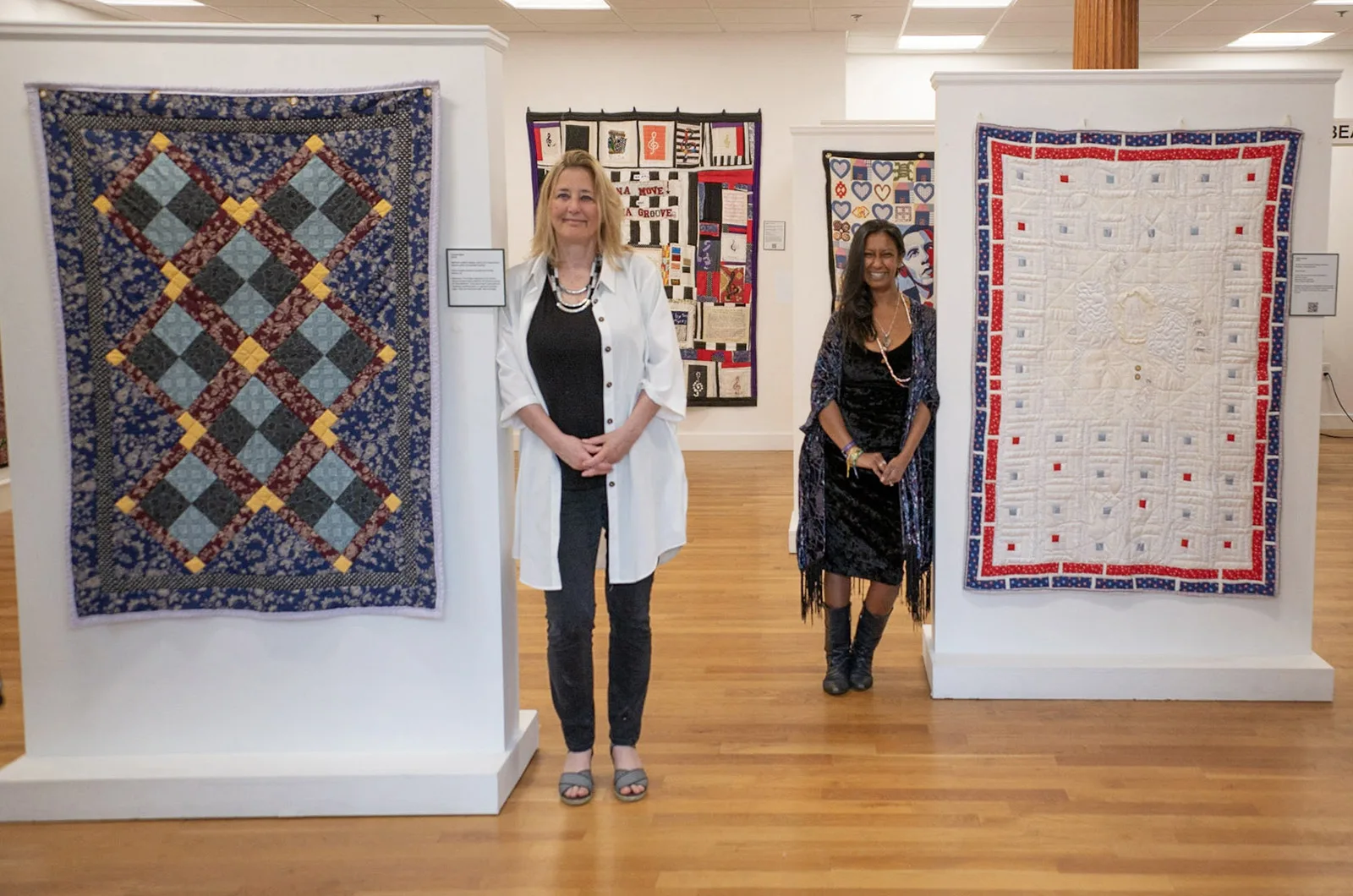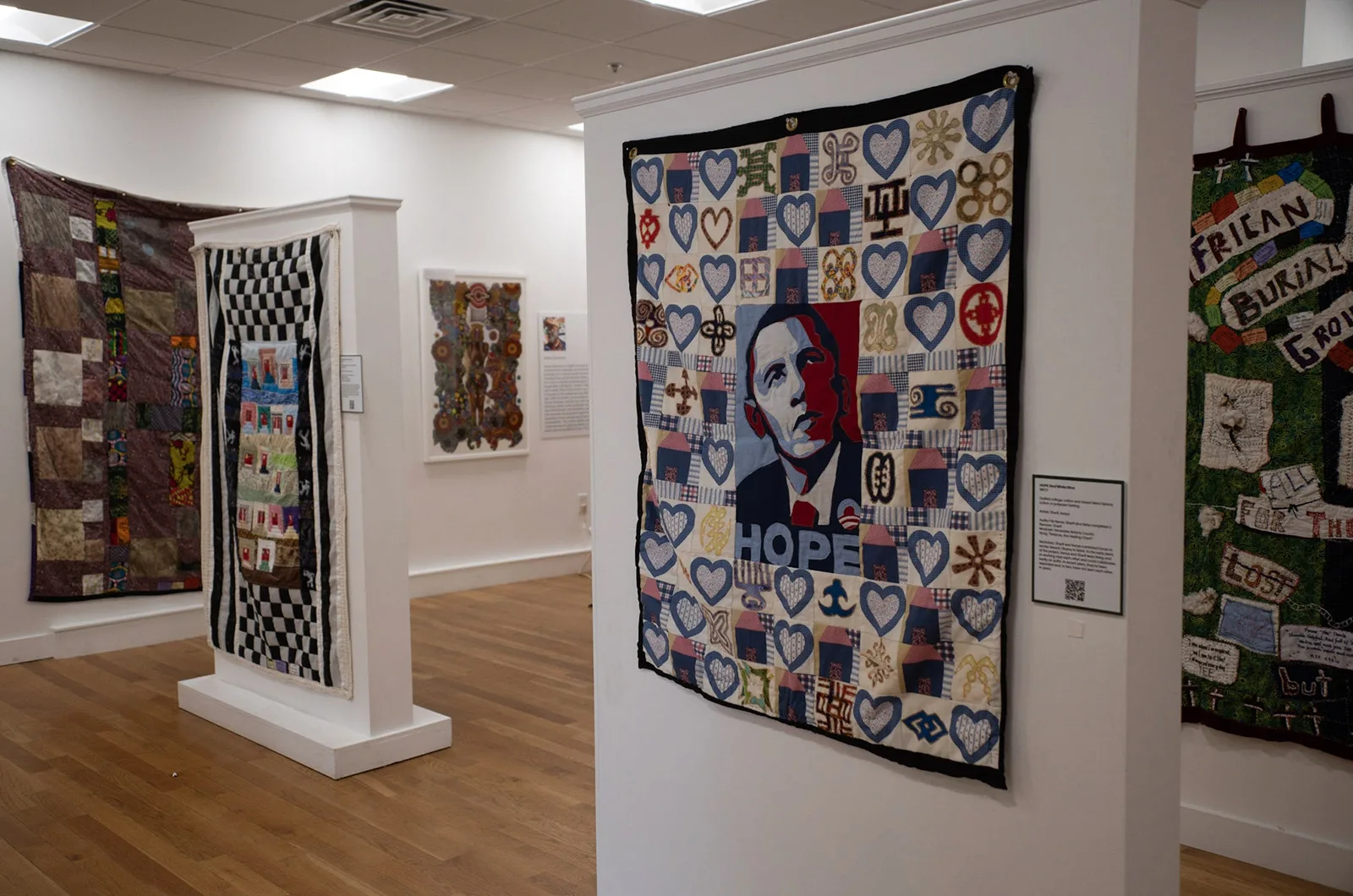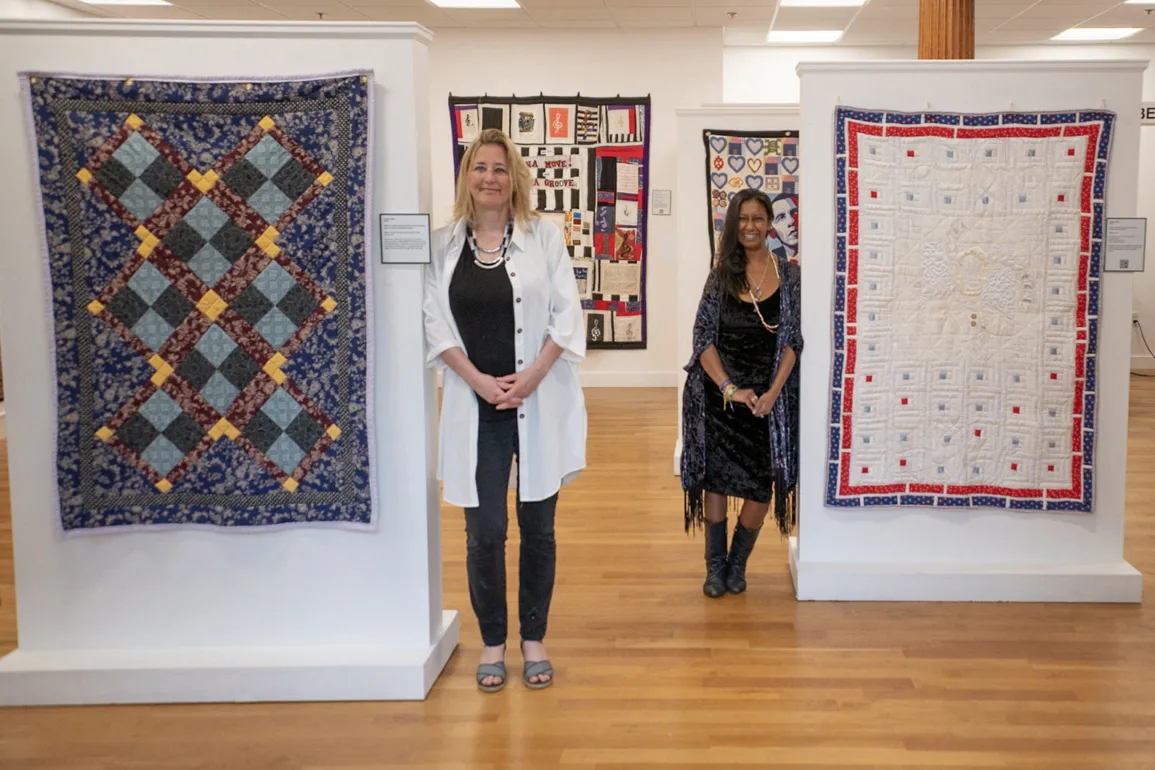An exhibit at the Mariposa Museum in Oak Bluffs is offering visitors a chance to engage with the experiences of people in the criminal justice system through an unexpected medium — a collection of quilts made through a collaboration between incarcerated and unincarcerated quilters.
The exhibit, Stitching Time: The Social Justice Collaboration Quilts Project, opened in August and will be at the museum until October 15. Many of the quilts include imagery focused on Blackness in America and the prison system, adorned with quotes from prominent civil rights activists and likenesses of James Baldwin and Barack Obama.
“The exhibit is about sharing the quilts and showing the world that, although people are incarcerated, they’re still creative,” said Maureen Kelleher, one of the quilts project’s co-founders. “They’re still human, they still have opinions, and they’re interested in the world.”
Ms. Kelleher co-founded The Social Justice Quilts Project with Kenya Baleech Alkebu, who is incarcerated at Louisiana State Penitentiary, known to many as Angola after the slave plantation that formerly occupied the land the prison sits on.

— Jeanna Shepard
The quilts project gives incarcerated and free quilters, or “inside quilters” and “outside quilters,” as Ms. Kelleher said, a chance to work on quilts together.
“The project is about quilts, but it also shows communication between inside quilters and outside quilters that has grown into care for each other,” Ms. Kelleher said.
About 18 inside quilters work with four outside quilters on the project. Many of those inside quilters are at Louisiana State Penitentiary, while some are incarcerated at other prisons around the United States.
Mr. Alkebu was making quilts for people receiving end-of-life care in the prison’s hospice program when Ms. Kelleher, a quilter herself, found out about his work. Mr. Alkebu, who has been incarcerated for 44 years at Angola, said quilting for the program at Angola prison has become part of his lifestyle.
“My desire to be a quilter in Angola’s Hospice Program stems from its collaborative energy — to assist both the incarcerated men who are dying in prison and those who love them,” he said in an email message to the Gazette.
Like the quilters of Gee’s Bend, a group of enslaved African American women from an isolated part of Alabama in the late 1800s, the inside quilters working with the project often piece together quilts from the scraps of fabric they can access in a very isolated place, Ms. Kelleher said. She was struck by the combination of art and care that she was seeing in the hospice program.

Some quilts include audio interviews with the creators.
— Jeanna Shepard
“I just thought, wow, you all are convicted felons, you’re from the Deep South, you’re doing this wonderful humanitarian work for other inmates who are dying — and all from prison,” Ms. Kelleher said.
Tex, who is also incarcerated at Angola, said that Ms. Kelleher’s care for the project has been apparent since the beginning.
“I thank Maureen for allowing us to share our art and gifts to the public,” he wrote in an email. “Maureen takes the time and gives us the opportunity to show the public a side of redemption that few get to see.”
Tex added that sharing the quilts gives people an opportunity to see what his and others’ lives are like in prison.
“People’s minds and hearts can be changed if they have the opportunity to see what inmates do behind the bricks,” he wrote. “To get a different perspective to the men here, to see that men can and will change.”
The exhibit’s first show was in 2019 and since then it has been to at least four museum or gallery spaces, most recently Mariposa in Oak Bluffs. More exhibits are in the works, Ms. Kelleher said.
After first experiencing the exhibit at the University of Massachusetts at Amherst, Mariposa’s executive director, Karla Hostetler immediately knew she wanted to show it at her museums.
The Mariposa Museum has two locations, one in Oak Bluffs and on Peterborough, N.H. Both museums are designed to showcase primarily Black scholarship, creativity and storytelling, Ms. Hostetler said. Three members of Mariposa’s board, Tracy Gee, Suesan Stoevall and Veta Richardson, make up a working group focused on driving the direction of the Oak Bluffs museum.
“The leadership here is very much in line with what the museum is all about,” Ms. Hostetler said. “I think we defy really easy categorization.”
The Oak Bluffs location opened in 2019 and its first exhibit was a collection of quilts made by African American women called And Still We Rise.
“It was really well received, and it’s what set us on our path for this space, which is about history, Black history, Black experience and culture,” Ms. Hostetler said. “So it felt really good to get back to quilts with this one, and in a really different way.”
Catherine Gomes, who is in charge of the museum’s day-to-day operations, said the exhibit is thought-provoking.
“Sometimes I think people don’t realize what they’re walking into,” she said. “And then when they come in, they see just how powerful it is.”
One of her favorite quilts, titled Ona Move! & Ona Groove, was created by 11 quilters including Mr. Akebu, Ms. Kelleher and Tex. Like some of the other quilts, it is accompanied by a QR code that takes viewers to an audio interview with one of the quilters — this one is with Tex.
The quilt, which takes up a large section of wall towards the back of the space, is made up of panels with each quilter’s interpretation of a treble clef and lyrics from a favorite song.
Ms. Hostetler said Stitching Time was the right exhibit for Mariposa at the right time, as it brings attention to the criminal justice system from the perspectives of people inside.
“It’s a one-of-a-kind exhibit,” Ms. Hostetler said. “It’s a way to connect with people that those of us on the outside rarely get to hear.”



